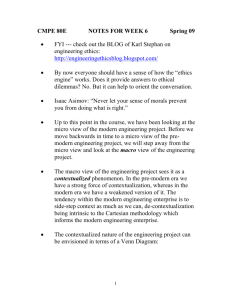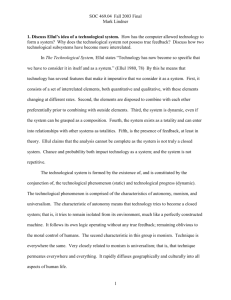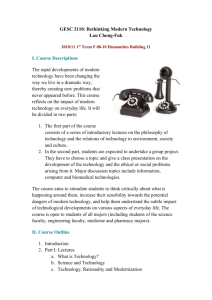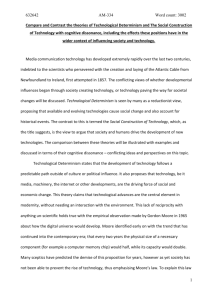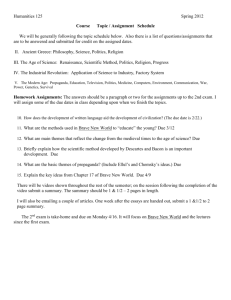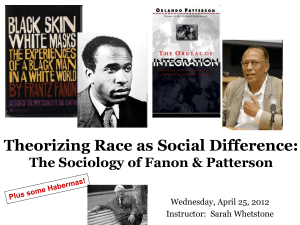NOTES FOR WEEK 6 Sp1..
advertisement
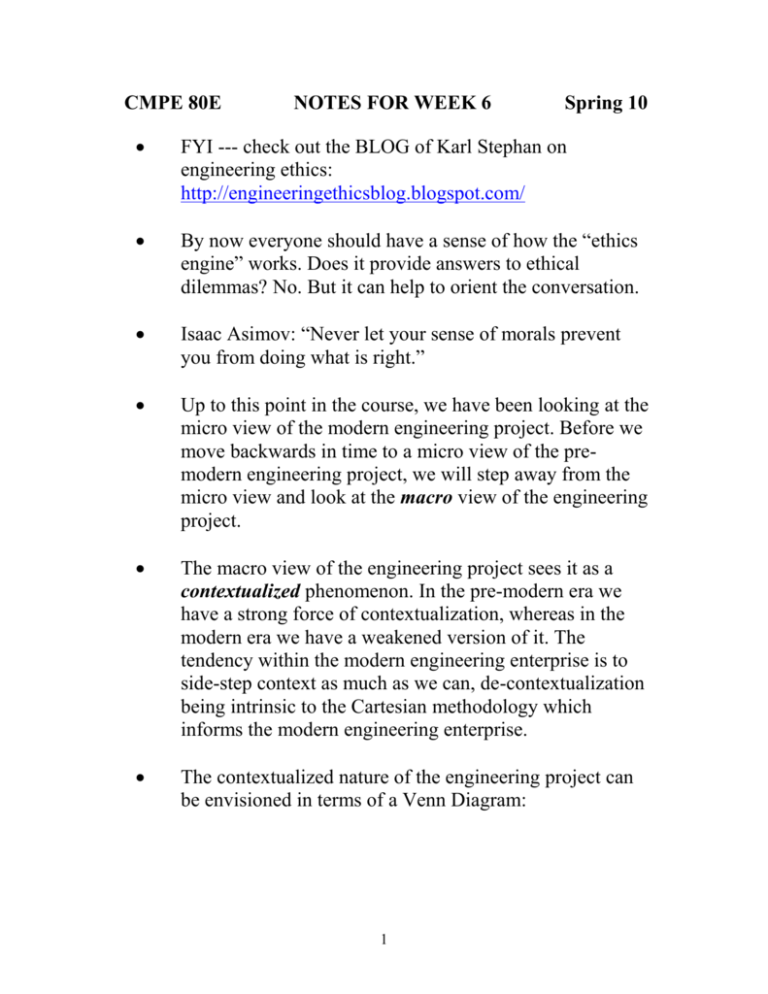
CMPE 80E NOTES FOR WEEK 6 Spring 10 FYI --- check out the BLOG of Karl Stephan on engineering ethics: http://engineeringethicsblog.blogspot.com/ By now everyone should have a sense of how the “ethics engine” works. Does it provide answers to ethical dilemmas? No. But it can help to orient the conversation. Isaac Asimov: “Never let your sense of morals prevent you from doing what is right.” Up to this point in the course, we have been looking at the micro view of the modern engineering project. Before we move backwards in time to a micro view of the premodern engineering project, we will step away from the micro view and look at the macro view of the engineering project. The macro view of the engineering project sees it as a contextualized phenomenon. In the pre-modern era we have a strong force of contextualization, whereas in the modern era we have a weakened version of it. The tendency within the modern engineering enterprise is to side-step context as much as we can, de-contextualization being intrinsic to the Cartesian methodology which informs the modern engineering enterprise. The contextualized nature of the engineering project can be envisioned in terms of a Venn Diagram: 1 CHPT 3 stresses COLONIZATION which is the primal force within the modern engineering enterprise. CHPT 6 stresses CONTEXTUALIZATION which is the primal force within the pre-modern engineering endeavor. Colonization implies that the principles and values of a systemic way of being – rationalization, efficiency, functionality, calculability, productivity, predictability, quantitative measures, and control – are imposed upon the non-systemic Human Lifeworld. Contextualization implies that communication and conversation of the lifeworld generates inputs to the systemic realm which influence and shape and form these systems. Both of these forces are generally operative. But if there is only colonization, that is called Technological Determinism, and if there is only contextualization, that is called Social Constructionism. 2 Technological Determinism has been championed by Jacques Ellul. Here are a bunch of ideas and quotes from an Ellul webpage: "Each of us, in his own life, must seek ways of resisting and transcending technological determinism.... The first act of freedom is to become aware of the necessity" - Jacques Ellul Ellul's Technological Society A remarkably perceptive viewpoint from sociologist Jacques Ellul in 1954. Technique: The totality of methods rationally arrived at and having absolute efficiency in every field of human activity (Ellul, p. xxv). "Technique is a means of apprehending reality, of acting on the world, which allows us to neglect all individual differences, all subjectivity. Technique alone is rigorously objective" (Ellul, p. 131). Technology: A design for instrumental action that reduces the uncertainty in the cause-effect relationships involved in achieving a desired outcome (Rogers, p. 12). History 3 "Everyone has been taught that technique is an application of science.... This traditional view is radically false. It takes into account only a single category of science and only a short period of time" (Ellul, p. 7). "The great preoccupation of the Greeks was balance, harmony and moderation; hence, they fiercely resisted the unrestrained force inherent in technique and rejected it because of its potentialities" (Ellul, p. 28-29). 16th-18th Century "Soon after its appearance the clock assumed its role of a status symbol.... Men began timing activities that, in the absence of clocks, they had never thought of timing. People became very conscious of time, and in the long run, punctuality became at the very same time, a need, a virtue, and an obsession. Thus a vicious circle was set into motion. As more and more people obtained clocks and watches, it became necessary for other people to possess similar contrivances, and the machines created the conditions for their own proliferation" (Cipolla, p. 104). 19th Century/Early 20th Century "The technical revolution meant the emergence of a state that was truly conscious of itself and was autonomous in relation to anything that did not serve its interests: a product of the French Revolution" (Ellul, p. 43). "The close link between scientific research and technical invention appears to be a new factor in the 19th century.... In the 20th century, this relationship between scientific research and technical invention resulted in the enslavement of science to technology" (Ellul, p. 45). Modern Technique "The multiplicity of means is reduced to one: the most efficient" (Ellul, p. 21). "The technical phenomenon cannot be broken down in such a way as to retain the good and reject the bad. It has a mass which renders it monistic.... All these techniques combine to form a whole, each part supporting and reinforcing the others" (Ellul, p. 111). "The scientific position frequently consists of denying the existence of whatever does not belong to current technical methods" (Ellul, p. 18). 4 Characteristics: Rationality - use of mathematical calculations, systematization, creation of standards Artificiality - creation of an artificial world radically different from the natural world Automatism - the technique becomes self-directing Efficiency - maximum yield with the least amount of effort Elimination of variability Laws of Self-Augmentation: Technical progress is irreversible Any new technique makes others possible Technical progress acts according to a geometric progression Consequences: "Since it was possible, it was necessary" - Jacques Soustelle on the atom bomb, May 1960 "Everything which is technique is necessarily used as soon as it is available without distinction of good or evil. This is the principal law of our age" - Jacques Ellul, 1954 Applications Homogenization of world culture "In the past, different civilizations took different paths; today all people follow the same road and the same impulse" (Ellul, p. 117). "Technical invasion does not put new wine into old bottles. The old bottles are all being broken. The old civilizations collapse on contact with the new" (Ellul, p. 121). "There is no place for an individual today unless he is a technician" (Ellul, p. 84). 5 Pace of life "There is no longer respite for reflecting or choosing or adapting oneself, or for acting or wishing or pulling oneself together. The rule of life is: No sooner said than done. Life has become a racecourse...a succession of objective events which drag us along and lead us astray without anything affording us the possibility of standing apart, taking stock, and ceasing to act" (Ellul, p. 330). "The interval which traditionally separates a scientific discovery and its application in everyday life has been progressively shortened..... The discovery enters the public domain before anyone has had a chance to recognize all the consequences or to recognize its full impact" (Ellul, p. 10). Disappearance of nature "We are rapidly approaching the time when there will no longer be any natural environment at all" (Ellul, p. 79). "It was a little work of art in a box, an artificial nightingale exactly like the living one, except that it was studded all over with diamonds, rubies, and sapphires. When the artificial bird was wound up, it could sing one of the songs the real one sang, and it wagged its tail, which glittered with silver and gold..... It sang the same tune three and thirty times over, and yet it was not tired.... The Emperor said that the real one must have a turn now. But where was it? No one had noticed that it had flown out of the open window, back to its own green woods.... All the courtiers said it was a most ungrateful bird. `We have got the best bird though,' said they, and then the artificial bird had to sing again.... The music master praised the bird tremendously and insisted that it was better than the real nightingale.... `You see...in the real nightingale you never know what you will hear, but in the artificial one everything is decided beforehand. ... The music master wrote five and twenty volumes about the artificial bird. The treatise was very long, and was written in all the most difficult Chinese characters. Everyone said they had read and understood it, for otherwise they would have been reckoned stupid.... But one evening, when the bird was singing its best and the Emperor was lying in bed listening to it, something gave way inside the bird with a whizz. Whiirr! went all the wheels, and the bird stopped." (Anderson, The Nightingale). Office Work "The conditions of war eventually become nearly his daily state; for the abnormal and the exceptional, with a somewhat lesser intensity, are reproduced regularly during the course of each day" (Ellul, pp. 320-321). "Men become accustomed to listening to machines and talking to machines.... No 6 more face to face encounters, no more dialogue" (Ellul, p. 379). "The optimum age of an employee who operates business machines would seem to lie between 16 and 22" (Ellul, p. 352). A well-known consulting firm hires its employees young and fires them when they become worn out. Our homes & entertainment "A house must be conceived less for the comfort of its occupants than for the accommodation of the numerous mechanical gadgets to be installed in it" (Ellul, p. 327). "The individual who is a servant of technique must be completely unconscious of himself" Ellul, (p. 138). "If he ever thinks...reflection tells him that there has not been anything between his adolescent adventures and his death.... Rather than face his own phantom, he seeks film phantoms onto which he can project himself and which permit him to live as he might have willed.... In short, he becomes a hero. Life suddenly has meaning" (Ellul, p. 377). "A great thunderstorm of sound gushed from the walls. Music bombarded him at such an intense volume that his bones were almost shaken from their tendons; he felt his jaw vibrate, his eyes wobble in his head. He was a victim of concussion. When it was all over he felt like a man who had been thrown from a cliff, whirled in a centrifugue, and spat out over a waterfall that fell and fell into emptiness and emptiness and never quite touched bottom... and you fell so fast you didn't touch the sides either... never... quite... touched... anything. The thunder faded. The music died. `There,' Mildred said." (Ray Bradbury, Fahrenheit 451) "Television, because of its power of fascination and its capacity of visual and auditory penetration, is probably the technical instrument which is most destructive of personality and of human relations. What man seeks is evidently an absolute distraction...and the simultaneous fusion of his consciousness with an omnipresent technical diversion" (Ellul, pp. 378-380). Human Techniques "Technique has taken over the whole of civilization. Death, procreation, birth, all must submit to technical efficiency and systematization" (Ellul, p. 128). "It is considered illusory to think it possible to construct a true system of 7 action from nonquantitative laws and observations. This was the traditional stumbling block for psychological techniques.... Progress came about only when the human sciences took on the exactitude of mathematics. Only metric methods can analyze and predict efficiently" (Ellul, p. 342). "Technique, in the form of psychotechnique, aspires to take over the individual, that is, to transform the qualitative into the quantitative. It knows only two possible solutions: the transformation or annihilation of the qualitative" (Ellul, pp. 286-287). "The individual is broken into a number of independent fragments, and no two techniques have the same dimensions or depth" (Ellul, p. 389). "The machine is a tool. But it is not a neutral tool. We are deeply influenced by the machine while using it" (Cipolla, p. 106). "What can one hope to deduce from the purely qualitative statement that the worker is fatigued? When biochemistry makes it possible to measure fatiguability numerically, it is at last possible to take account of the worker's fatigue" (Ellul, p. 18). "Imagine an instrument that can monitor the brain for signs of fatigue and then issue a warning before a serious accident occurs. The fatigue monitor being developed at the University of Technology, Sydney, uses electrodes to monitor brainwaves" (Australian Web site). Performance engineering (human performance technology) "Technique is the instrument of performance" (Ellul, 1954). "The way to achieve human competence is to increase the value of our accomplishments while reducing the energy we put into the effort" (Gilbert, 1978). Gilbert's First Leisurely Theorem (Gilbert, p. 18): Human competence is a function of worthy performance (W), which is a function of the ratio of valuable accomplishments (A) to costly behavior (B). Or, W = A/B. Gilbert's Second Leisurely Theorem (Gilbert, p. 30): Typical competence is inversely proportional to the Potential for Improving Performance (the PIP), which is the ratio of exemplary performance to typical performance. That is, PIP = Wex/Wt. We can alter Behavior by altering a Person's repertory of behavior or by changing the Environment in which he functions, or: B = E times P. 8 The Basic Worth formula (Gilbert, p. 139) adds the role of Management to the equation: W = A/(E + P + M). Education "It is the findings of thousands of educators which ceaselessly nourish the improvement of technique" (Ellul, p. 86). "Education no longer has a humanist end or any value in itself; it has only one goal, to create technicians" (Ellul, p. 248). A software product, the Intelligent Essay Assessor, can grade student essays and provide feedback. By providing the software with sample "good" essays, the software can "learn" what makes a good essay (Technology Training, Feb. 1999). "What looks like the apex of humanism is in fact the pinnacle of human submission: children are educated to become precisely what society expects of them" (Ellul, p. 348). "The conditions for psychological efficiency are, first, group integration, and second, group unanimity. The purpose of psychological methods is to neutralize or eliminate aberrant individuals" (Ellul, p. 410). Politics "When there is propaganda, we are no longer able to evaluate certain questions, or even to discuss them" - Jacques Ellul, 1954 "Propaganda is not the defense of an idea but the manipulation of the mob's subconscious. The hope reposed in the contradictions of propaganda comes to this: the citizen receives a blow in the face from his neighbor on the right, which, fortunately, is compensated for by another blow from his neighbor on the left. If propaganda involved calm exposition of political theories among which the citizen might choose intelligently, contradictions would be beneficial... But this is an impossibility" (Ellul, pp. 373-374). "Our civilization sets the highest value on brotherly relations. But the structures of our world and its real norms represent diametrically the opposite. The fundamental rule of today is the rule of economic, political, and class competition. The disequilibrium...has produced the climate of anxiety and insecurity characteristic of our epoch and of our neuroses" (Ellul, p. 333). The subconscious 9 "Every technique makes a fundamental appeal to the unconscious" (Ellul, p. 403). "It is highly significant that technical elements begin to appear in what the psychoanalysis call the `great dreams.' This mechanical penetration of the unconscious indicates that nothing human is exempt from the influence of technique" (Ellul, pp. 403-404). Over the past year a struggle of mythic proportion has gone on nightly in my dreams between the world of technology and the world of intuition and emotion. This is one of my dreams: "I am the leader of a tribe of Amazons fighting another group in a struggle to the death. The women on the other side surrender to us. We kill all the males. I kill the last one by plunging a dagger into him several times (though I hate doing it). Some sort of parade is going through town composed of giant metal contraptions filled with small children. We shout `Charge!' and attack the metal contraptions, tipping them over, but try not to injure the children inside. I see that the machinery is being telepathically powered by two male cyborgs. We manage to free the children. But now a shifting of the ground has caused a giant wave to threaten the town. We run to a barrier that divides the town into two rooms. There are lots of pebbles piled near the door. I open the door, and multicolored sand comes pouring out of the other room: dark red and amber and beige and gold. If I can empty this room we can run into it, seal ourselves off from the approaching sea, and be safe." The End of Individualism "When a society becomes increasingly totalitarian...[it] requires its citizens to be conformist in the same degree. Thus, technique becomes all the more necessary. I have no doubt that it makes men better balanced and `happier.' And there is the danger. It makes men happy in a milieu which normally would have made them unhappy" (Ellul, p. 348) "Technique cannot be otherwise than totalitarian. Everything is its concern" (Ellul, p. 125). "The individual participates only to the degree that he is subordinate to the search for efficiency, to the degree that he resists all the currents today considered secondary, such as aesthetics, ethics, fantasy" (Ellul, p. 74). "The enormous effort required to put this technical civilization into motion supposes that all individual effort is directed toward this goal alone.... Henceforth...the individual will no longer be able, materially or spiritually, to disengage himself from society" (Ellul, p. 248). 10 "Technical civilization has made a great error in not suppressing death, the only human reality still intact" - Jacques Ellul, 1954 References Anderson, H.C. (1965). The nightingale. In Anderson's Fairy Tales (Illustrated Junior Library edition, pp. 243-255). New York: Grosset & Dunlap. Bradbury, R. (1953). Fahrenheit 451. New York: Ballantine Books. Cipolla, C.M. Clocks and culture, 1300-1700. New York: Norton & Co. Ellul, J. (1964 American edition; the French edition was published in 1954). The technological society. New York: Vintage Books. Gilbert, T. F. (1996). Human competence: Engineering worthy performance (tribute edition). Washington, DC: International Society for Performance Improvement. Rogers, E .M. (1995). Diffusion of innovations (4th edition). New York: The Free Press. Social Constructionism has been championed by STS, which is the study of how social, political, and cultural values affect scientific research and technological innovation, and how these in turn affect society, politics, and culture. STS scholars are interested in a variety of problems including the relationships between scientific and technological innovations and society, and the directions and risks of science and technology. STS was originally known as Science, Technology, and Society but in more recent years has been known as Science and Technology Studies. STS people in general are opposed to the idea of Technological Determinism. 11 Engineering is both world-shaping and world-shaped. The forces of contextualization and colonization are both always already operative. Colonization is more pronounced in the modern engineering enterprise and contextualization more so in the pre-modern engineering endeavor. We will seek a balance within the focal engineering venture. So colonization of the Lifeworld by the realm of System is a major event of the modern era (according to Habermas). Lifeworld = the wherein wherein what comes to be comes to be. Lifeworld (German: Lebenswelt) is a concept used in philosophy and in some social sciences, meaning the world "as lived" prior to reflective re-presentation or analysis. Edmund Husserl introduced the concept of the lifeworld in his ''Crisis of European Sciences'' (1936) 12 following Martin Heidegger's analysis of Being-in-theworld (In-der-Welt-Sein) in ''Being and Time''. The concept was still further developed by students Jan Patočka, the Husserlian Alfred Schütz, Maurice MerleauPonty, Jürgen Habermas, and others. For Habermas, lifeworld is more or less the "background" environment of competences, practices, and attitudes representable in terms of one's cognitive horizon. It's the lived realm of informal, culturally-grounded understandings and mutual accommodations. Rationalization of the lifeworld is a keynote of Habermas's 2-volume ''Theory of Communicative Action''. Penetration of lifeworld rationality by bureaucracy is analyzed by Habermas as 'colonization of the lifeworld'. Social coordination and systemic regulation occur by means of shared practices, beliefs, values, and structures of interaction, which may be institutionally based. We are inevitably lifeworldly, such that individuals and interactions draw from custom and cultural traditions to construct identities, define situations (at best, by coming to understandings, but also by negotiations), to coordinate action, and create social solidarity. Q: how far do we go with colonization assuming it is not an irresistible force? e.g. shopping cart but not hi-tech version? e.g. ubiquitous computing? The Human Lifeworld BINDS and CONSTRAINS and ORIENTS the engineering project (always) even as a plethora of engineered products pervade and transform the Lifeworld. If only the “pervading” is taken into account (as in modernism), we have Technological Determinism which implies that we have a ZEITGEIST which conditions us all to be 100% efficient in a thoroughly 13 technological world. This is basically Jacques Ellul’s position. Martin Heidegger’s position is similar. He maintains that Being shows itself as the framework (das Gestell), which befalls us like an irresistible force, a Technological Zeitgeist, within which all beings become resources (das Bestand). Triple Colonization and Triple Contextualization: Watch video “Ethics in Biomedical Research” and do an in-class writing exercise. A few notes on “Notes on Habermas”: The core of any action is communication. We need to create opportunities for communication. As the premodern era gave way to the modern era and advanced capitalist societies developed, the core integrative function of communication has been disabled (colonized). 14 Colonization undermines our trust in the legitimacy of our institutions. Guided by values of efficiency and productivity our institutions appear more and more cold and inhospitable. We should restore communicative action to restore legitimacy e.g. promote participatory democracy based on the rights of individuals and guided by reasoned discourse … this is the best hope for society (says Habermas). A-G-I-L work together to explain societal stability: A = Adaption which depends on the generalized medium of money. G = Goal attainment which depends on power (votes). I = Influence. L = Values commitments. A & G indicate money & votes or power which can be counted and are active in the realm of system and are QUANTITATIVE (whoever has the most wins) whereas I & L are enacted in communication between persons and are active in the realm of the non-systemic lifeworld and are QUALITATIVE. Colonization implies that social settings that were I & L orientated via qualitative communicative media now become dominated by A & G quantitative media. (No conversation of the Lifeworld, just count the money or votes.) KEY IDEA: the legitimacy of SYSTEM depends on the constant acts of influence & value-commitment intrinsic to LIFEWORLD. And as system colonizes lifeworld we come closer and closer to CRISIS. 15 Money and votes can certainly be useful in getting things done, but only so long as their legitimacy is assured by the common understanding of influence & valuecommitments. Via communicative action and the conversation of the lifeworld, the colonizing effects of SYSTEM are mitigated. Contextualization counters colonization. A few more ideas drawn from CHPTS 3 & 6: Andrew Feenberg proposes what he calls Primary Instumentalization (PI) & Secondary Instrumentalization (SI) Primary Instrumentalization Heidegger and Habermas offer insight only into what I will call the "primary instrumentalization" of the technical object by which a function is separated from the continuum of everyday life. Primary instrumentalization characterizes technical relations in every society, although its emphasis, range of application and social significance varies greatly. It can be summarized as four reifying moments of technical practice: 1. Decontextualization To reconstitute natural objects as technical objects, they must be "de-worlded," artificially separated from the context in which they are originally found so as to be integrated to a technical system. Once isolated they can be analyzed in terms of the utility of their various parts, and the technical schemas these contain can then be released for general application. For example, an invention such as the knife takes the sharpness of some natural thing, such as a rock, and releases it as a technical property from the role it plays in nature. Technology is constructed from such fragments of nature that, after being abstracted from all specific contexts, appear in a technically useful form. 2. Reductionism Reductionism refers to the process in which the de-worlded things are simplified, stripped of technically useless qualities, and reduced to those aspects through which they can be enrolled in a technical network. I will call these latter "primary qualities," primary 16 that is from the standpoint of the technical subject for whom they are a power base. These are the dimensions of the object which can be reorganized around an alien commanding interest, while "secondary qualities" are vestiges of untransformable stuff tying the object to its pretechnical history and its potential for self-development. To the extent that all of reality comes under the sign of technique, the real is progressively reduced to these primary qualities. 3. Autonomization The subject of technical action isolates itself as much as possible from the effects of its action on its objects. This suggest a metaphoric application to society of Newton's third law: "for every action there is an equal and opposite reaction." In mechanics, actor and object belong to the same system and so every effect is simultaneously a cause, every object simultaneously a subject. This is not a bad description of ordinary human relations. But technical action autonomizes the subject through dissipating or deferring feedback from the object of action to the actor. The subject is largely unaffected by the object on which it acts, thus forming an apparent exception to Newton's law. The autonomization of the subject has momentous social implications under capitalism, where subject (manager) and object (worker) are human beings. 4. Positioning Francis Bacon wrote that "Nature to be commanded must be obeyed." The technical subject does not modify the basic "law" of its objects, but rather uses that law to advantage. The law of gravity is present in the clock's pendulum, the properties of electricity in the design of the circuit, and so on. In dealing with complex systems that cannot be reduced to artifacts, such as workforces and markets, Baconian obedience means adopting a strategic location with respect to the object. In a sense all technique is navigation, falling in with the object's own tendencies to extract a desired outcome. By positioning itself strategically with respect to its objects, the technical subject turns their inherent properties to account. Secondary Instrumentalization This list of primary instrumentalizations does not exhaust the meaning of technique. Technique also has integrative potentialities that compensate for some of the reifying effects of the primary instrumentalization. Here technical systems turn back on themselves and their users as they are embedded in their wider social and natural context, reappropriating some of the dimensions of contextual relatedness and self-development from which abstraction was originally made in establishing the technical object relation. On the basis of this concept of integration, I argue that technique is fundamentally social. Its "essence" must include what I call a "secondary instrumentalization" that works with dimensions of reality from which abstraction is made at the primary level. This level of technique includes the following four moments: 17 1. Systematization Isolated, decontextualized technical objects must be combined with other technical objects and re-embedded in the natural environment in order to function as an actual device. Systematization is the process of making these combinations and connections. The underdetermined character of the final product of any technological development leaves room for social interests and values to intervene in the process of systematization. As decontextualized elements are combined, these interests and values orient choices and insure congruence between technology and society at the technical level itself. The process of systematization is central to designing the tightly coupled networks of modern technological societies but plays a lesser role in traditional societies where technologies may be more loosely related. 2. Mediation In all societies, ethical and aesthetic mediations supply the simplified technical object with new secondary qualities that seamlessly reinsert it into its new social context. The ornamentation of artifacts and their investment with ethical meaning is integral to production in all traditional cultures. Only modern industrial societies distinguish production from aesthetics through indifference to the social insertion of their objects, the substitution of packaging for an inherent aesthetic elaboration, or aesthetic functionalism. From this results the artificial separation of technique and aesthetics characteristic of our societies. Ethical limits too are overthrown in the breakdown of religious and craft traditions. In any case, however marginalized, mediations remain an essential aspect of the technical process. 3. Vocation The autonomization of the technical subject is overcome in the recognition of the human significance of vocation, the acquisition of craft. In vocation, the subject is no longer isolated from objects, but is transformed by its own technical relation to them. This relation exceeds passive contemplation or external manipulation and involves the worker as bodily subject and member of a community in the life of its objects. The idea of vocation or "way" is an essential dimension of even the most humble technical practices in some traditional cultures, such as the Japanese, but tends to be artificially reserved for professions such as medicine in most industrial societies. 4. Initiative Finally, to positioning as the basis of strategic control of the work process and the consumer there corresponds the praxis of voluntary cooperation in the coordination of effort. In precapitalist societies, such cooperation was often regulated by tradition or paternal authority. Collegiality is an alternative to bureaucratic control in modern societies with widespread if imperfect applications in the organization of professionals such as teachers and doctors. Reformed and generalized, it has the potential for reducing alienation through substituting self-organization for control from above. In the sphere of 18 consumption, informal coordination often appears as the users of products appropriate them for unintended purposes. Reflexive Technology Secondary instrumentalizations support the reintegration of object with context, primary with secondary qualities, subject with object, and leadership with group through a reflexive meta-technical practice that treats technical objects and the technical relationship itself as raw material for more complex forms of technical action. There is of course something paradoxical about this association of reflexivity with technology; in the framework Heidegger and Habermas share technical rationality is supposed to be blind to itself. On this account, one could still admit the existence of something like the secondary instrumentalizations described above, but they would be extrinsic social influences on technology rather than a dimension of its essence. Isn't this a more plausible approach than the one taken here? Plausible it may be, but it also contradicts what we know of technology from a wide range of recent research. The social is far more deeply implicated in technology than the essentialist concept of extrinsic "influence" admits. That concept accounts (rather poorly) for only half a story which actually has two parts. In the first place, primary and secondary instrumentalizations may be more or less differentiated depending on the stage of technical and social development. For example, in a premodern society there may be no very clear distinction between narrowly conceived technical ends and aesthetic mediations. The shape of a pot or the color of an arrow's feathers are not ornamentation in our sense, but belong integrally to the design of the artifact. In our society, on the contrary, these different aspects of technical work are not only clearly distinguished but often embodied in different institutions. Habermas has taken such differentiation to be the essence of modernity and the proof that the social and the technical are fundamentally separate, but this overlooks a second aspect of technical development. In both premodern and modern societies secondary instrumentalizations often shape devices through cleverly conceived designs that also optimize efficiency. In such cases we can still make an analytic distinction between, for example, the aesthetic form and the technical function of a streamlined vehicle, but no real distinction exists. Here the social is not differentiated from the technical but merged with it. In sum, a technological design may embody a social constraint or that constraint may operate through external regulation. In the first case technical and social relations are condensed in the design of the device. Here the distinction is purely analytic and corresponds to no specifically technical or social structures. In the second case the distinction is a real one: on the one side there is a device and on the other a law, regulation, or social demand which determines its employment. But in both cases, even in the case where no external regulation is apparent, society is implicated in technological design. 19 Time permitting, we will have a group exercise. Homework for the weekend: a) EP Chapter 4 (Person) b) the essay “Capitalism, Work, and Character” c) the essay “Platonic Virtue Theory and Business Ethics,” d) the short piece on “The Earliest Engineers” e) write one page explaining the relevance of the Platonic system of ethics for the modern engineering enterprise. 20

